4H P3a Ikigai, Oriëntatie op Studie en Beroep (Domein F)

Ask your teacher to discuss this page in class
Zweef met je muis boven de moeilijke dikgedrukte woorden om de betekenis te zien.
Dear pupils,
At some point during our time in school, we often reach a fork in the road where we have to decide what to do next. We think about our future, our interests, and the direction we should take after school. It’s a normal part of the process, and it’s okay to feel a lot of different feelings, like worry, excitement, or even a lack of motivation.
Every few years, you either have to make a choice (group 8, de brugklas dakpanklassen, 3e klas profielkeuze) or get the chance to go in a different direction (keuze voor studeren / niet studeren / een tussenjaar / een leven als ondernemer, activist of kunstenaar, etc.).
The end of 4H is coming up quickly, and you will probably graduate next year, decide to give vwo a go or in fact, to go to MBO after this year. Whatever you choose, you will probably go on with your life somewhere other than the GSG Leo Vroman.

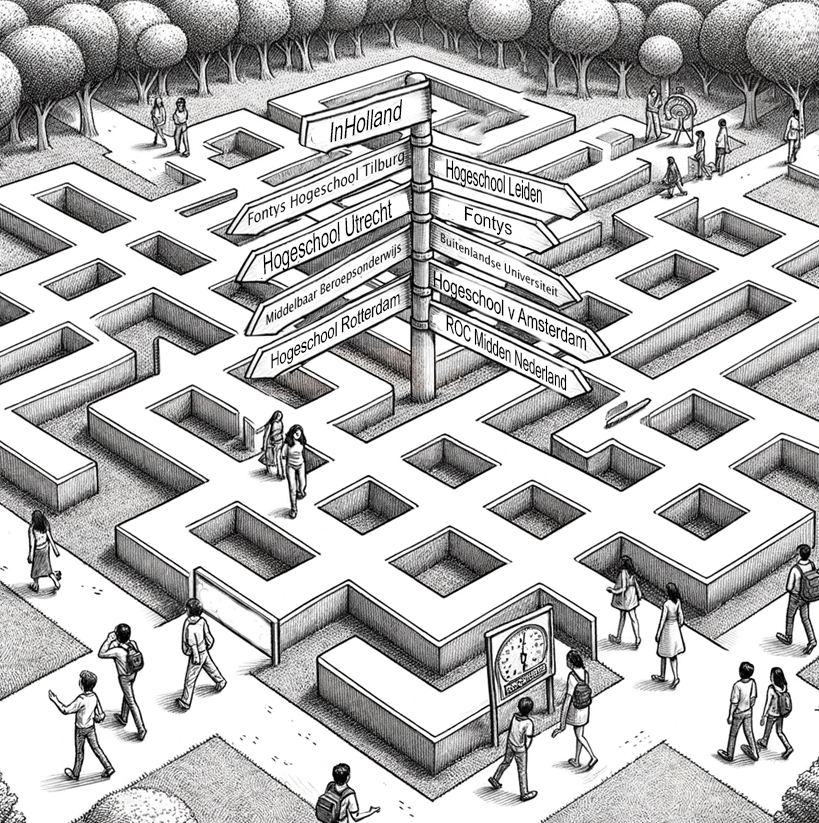
This Project: using IKIGAI
We want to tell you about an interesting project that is based on a beautiful Japanese idea called “Ikigai,” which means “a reason for being.” Ikigai is when what you love, what you’re good at, what the world needs, and what you can get paid for all come together. Finding happiness, satisfaction, and peace in the everyday things of life is what it’s about.

Do I even have options?

You might be wondering how this relates to our school schedule, which is made up of set times and courses.
Even though school is organized, it’s also a great place to learn, grow, and find out more about yourself. It gives you a look into a huge world of information and skills, some of which might spark an interest in you.
Our Goals
The point of this project isn’t to add more stress to your already busy schedule, but to give you a new way to look at the people, things, and things you learn every day. Understanding that even in planned situations, you can find things that connect with your personality, hobbies, and goals for the future is important.
You are invited to explore yourself through this project, to think, to work together, and to share what you find through creative spoken outputs. If you want to, you can work on projects that interest you, have discussions with your friends, or even talk to people who have already started their own Ikigai journeys.
Of course, not every subject or job will interest you, and that’s fine. Learning to think in a way that helps you sort through the musts and the wants will help you find a good balance and get closer to a future where you can grow.
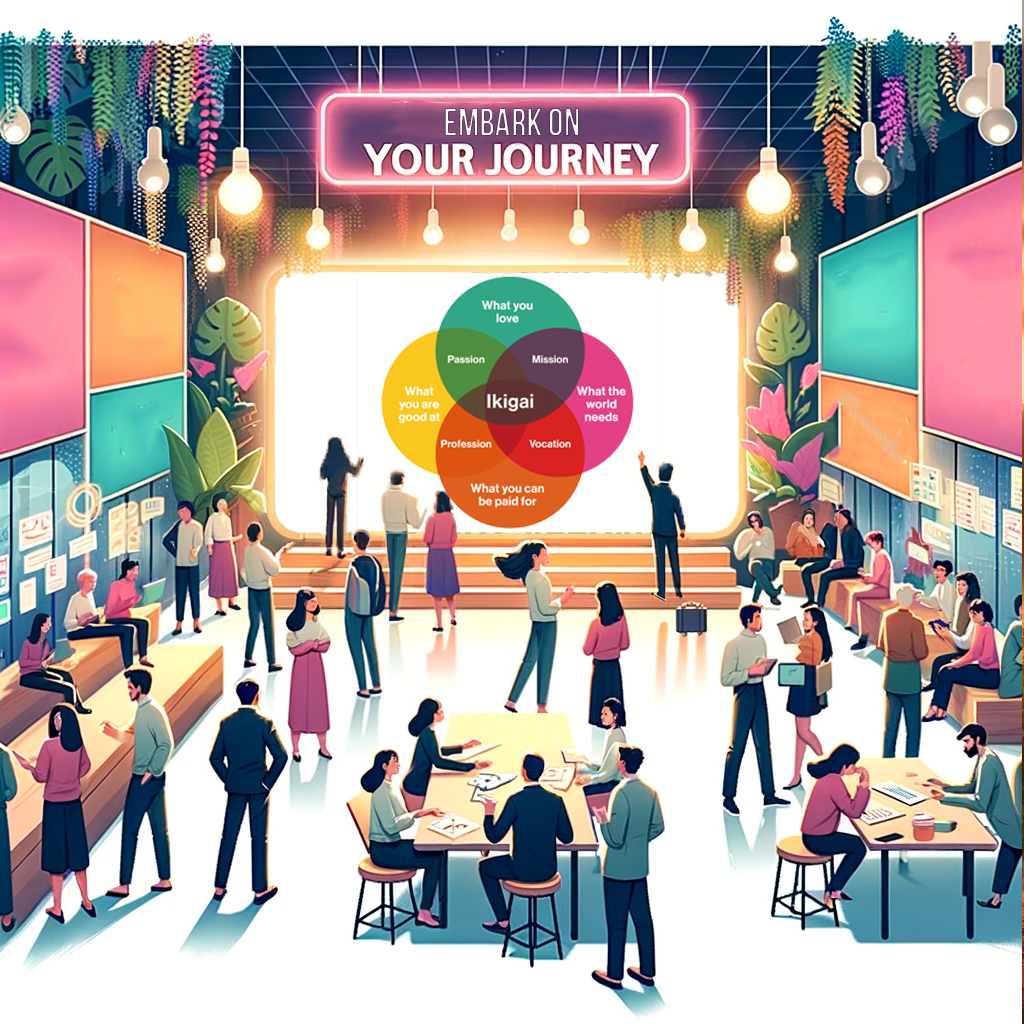
This is about you

As you work on this project, keep in mind that the path to self-discovery is a special one that takes time to develop. This will help you learn more about yourself, and you never know—you might find hidden hobbies and interests just waiting to be sparked.
Let’s go on this journey together, with an open mind, a heart full of wonder, and a group that will support us. People in your class and on the playground are always here for you.
The Road Not Taken
You can read about what it means here.
BY ROBERT FROST
Two roads diverged in a yellow wood,
And sorry I could not travel both
And be one traveler, long I stood
And looked down one as far as I could
To where it bent in the undergrowth;
Then took the other, as just as fair,
And having perhaps the better claim,
Because it was grassy and wanted wear;
Though as for that the passing there
Had worn them really about the same,
And both that morning equally lay
In leaves no step had trodden black.
Oh, I kept the first for another day!
Yet knowing how way leads on to way,
I doubted if I should ever come back.
I shall be telling this with a sigh
Somewhere ages and ages hence:
Two roads diverged in a wood, and I—
I took the one less traveled by,
And that has made all the difference.
The Assignments/Products you Can Choose
You are going to…
- Choose one of these assignments/products.
- You may work together in some of these assignments.
- Max 5 pupils per group and 6-8 minutes per pupil.
- You may work together in some of these assignments.
Elaborate Instructions For Each Assignment/Product
The descriptions below are brief instructions that give you an idea of each choice. Elaborate instructions that you must follow can be found in the Exploration Stage.
Talk to people (Conduct Interviews) who have found their Ikigai and then either make a video report or a podcast about what you learned.
You and the person you interviewed must be heard in the podcast or documentary through shots or clips from the real conversation.
Think about how the person you interviewed’s story could help you on your own and include those reflections in the podcast or video report.
Reflect on this in the video documentary or podcast itself.
Your reflections may be recorded seperately and edited into the documentary or podcast later.
Multiplier
The following Multiplier Information Graph shows you the time estimation, expected difficulty and anticipated learning/reflection reward.

Engage in a role-play scenario with a partner where one of you is a career counselor and the other is exploring their Ikigai.
Document this role-play in a video and reflect out loud on the insights gained regarding your future paths.
This reflection has to be dialogue-style meaning you do it together. The reflection must be part of the video and has to be recorded directly following the role-play without any cuts in the video.
Multiplier
The following Multiplier Information Graph shows you the time estimation, expected difficulty and anticipated learning/reflection reward.
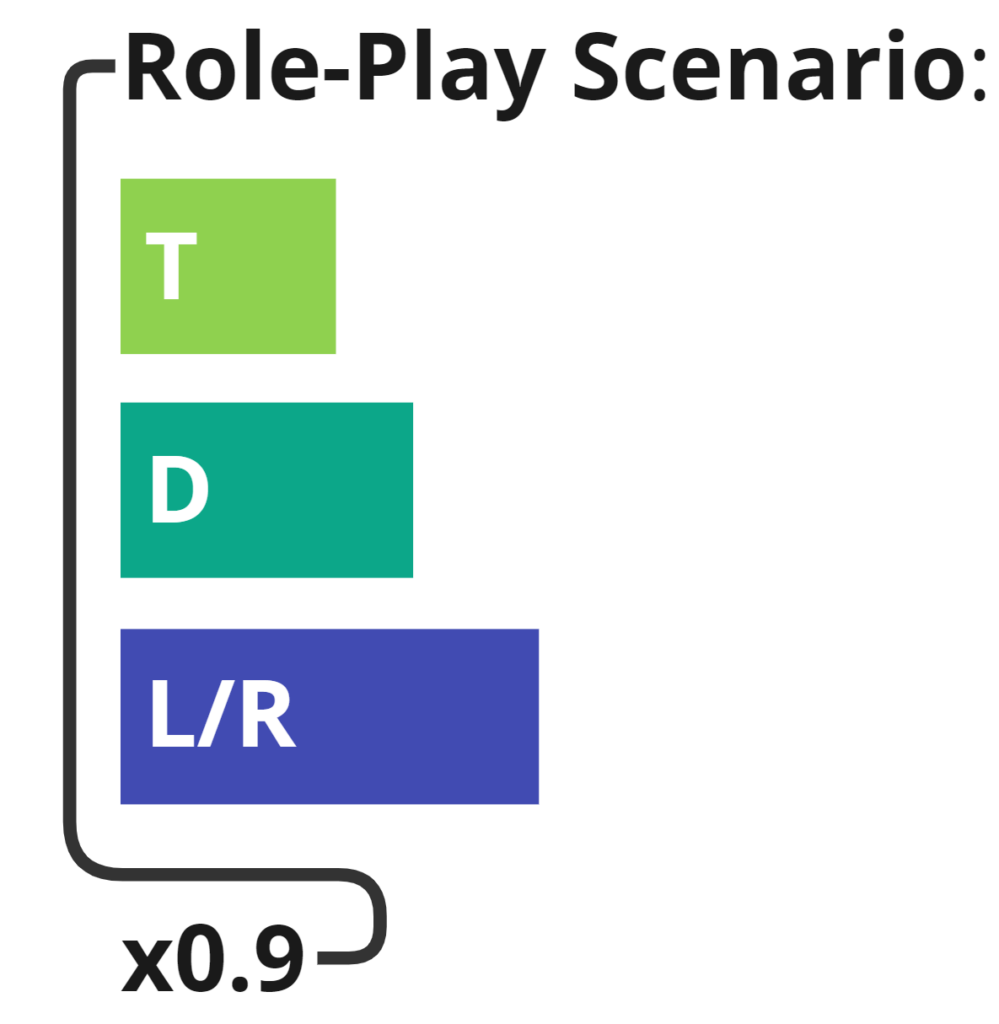
Make a pre-recorded video speech and show it to your class about what you know about Ikigai and how it might affect the choices you make after high school.
You should record your speech so that you can go over it in class, and then you should write a note about how researching your ikigai and getting ready for the speech have helped you figure out what you want to do in the future. This is also recorded.
Multiplier
The following Multiplier Information Graph shows you the time estimation, expected difficulty and anticipated learning/reflection reward.

Set up a panel discussion with people who have already found their Ikigai to talk about the challenges and benefits of the journey. Tip! Ask people who used to go to GSG to come talk about their life after GSG.
The panel discussion needs to be planned and led by you (or you and one or two others). Write down what was said and think about how the ideas could change your own path.
This reflection could be a separate recording, but it has to be in the same film, so make the two fit together.
It’s important to remember that all 4th graders must include a summary as part of their work. It would be best if you and your partner did the reflection dialogue style after the panel session.
Multiplier
The following Multiplier Information Graph shows you the time estimation, expected difficulty and anticipated learning/reflection reward.

Design and conduct a workshop for your peers (4 havo) and/or 4 mavo and/or and/or 5 havo and/or 4 vwo and/or 6 vwo pupils to help them explore their Ikigai.
Record the workshop, gather feedback from participants, and reflect on the experience in a spoken presentation that you add as a recording or a voice over part of the video materials created during the workshop.
All 4 havo pupils part of the workshop assignment / product need to be equally present in the voice-over reflection.
Multiplier
The following Multiplier Information Graph shows you the time estimation, expected difficulty and anticipated learning/reflection reward.

Make up a story with pictures that shows how you found Ikigai by your trip.
Record your story-telling session and then think about the lessons and morals it teaches you about finding your way in life.
This thought should be added as a sit-down chat for creative executives after the show is over or backstage.
Multiplier
The following Multiplier Information Graph shows you the time estimation, expected difficulty and anticipated learning/reflection reward.

Identify a community need and design a project:
Find a need in the community and use your unique skills and hobbies to come up with a project that fills it.
Make a podcast or video show about the process and the results.
You can reflect in a video or voice-over that you can record separately and then add to the film. Think about what your Ikigai has taught you through your group project.
Everyone who worked on this project needs to be present at the reflection part of this task.
Multiplier
The following Multiplier Information Graph shows you the time estimation, expected difficulty and anticipated learning/reflection reward.

Follow a worker in a field that interests you (Professional Shadowing) and make a podcast or video documentary about how this experience fits with what you think your Ikigai is.
You will automatically be reflecting on this task when you talk about how your experience fits with the ikigai of the person(s) you shadow.
Multiplier
The following Multiplier Information Graph shows you the time estimation, expected difficulty and anticipated learning/reflection reward.
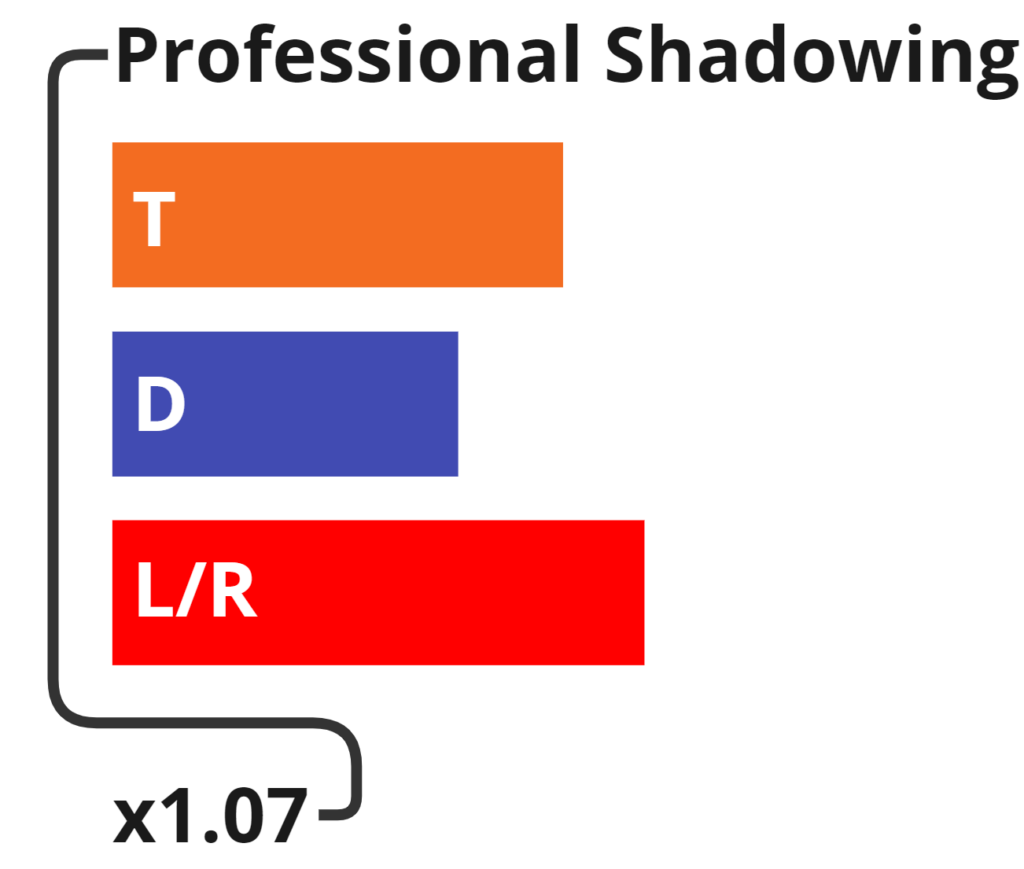
Make a visual map of your Ikigai. Include your interests, skills, the needs you want to fill in society, and possible jobs that fit these categories. Record yourself presenting it.
Think about how making the visual ikigai map has helped you grow in terms of shaping your own vision for the future in the same movie and clip.
Multiplier
The following Multiplier Information Graph shows you the time estimation, expected difficulty and anticipated learning/reflection reward.

Make a podcast series with other people who have found their Ikigai to talk about different parts of it. The people you talk to could be peers, students, activists, start-up entrepreneurs, teachers, family members, or other people who have found their Ikigai.
Talk about how learning Ikigai can affect the subjects or careers you choose after high school.
At the end of each episode or the end of the show, think about how other people’s stories have affected your plans for the future. As part of the episodes, all members need to be able to be heard and respond in the same way.
It is up to you how to divide to reflections across and in which moments of the episodes.
Multiplier
The following Multiplier Information Graph shows you the time estimation, expected difficulty and anticipated learning/reflection reward.
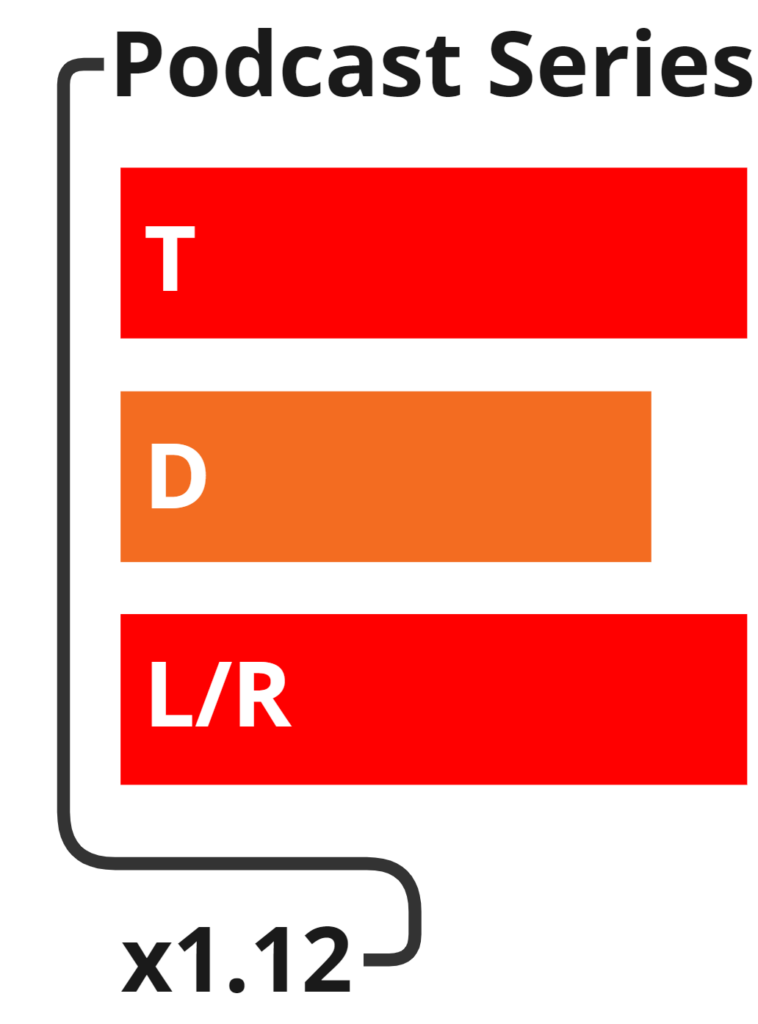
Participate in a debate: Join a discussion about the subject of Ikigai. Pick one of these ten questions, or make up your own (and get permission to do so).
- Why Ikigai is Important for Happiness:
- Should everyone find their Ikigai in order to live a happy life, or are there other ways to be happy?
- Ikigai in the Classroom:
- If so, should Ikigai principles be used in schools to help kids find their interests and job paths early on?
- Ikigai and Being Happy with Your Job:
- Are following one’s Ikigai and financial pay more important factors in determining job satisfaction?
- Possibility of Going After Ikigai:
- Is it possible for everyone to follow their Ikigai, or is that something that only a few people can do?
- Practicality vs. Ikigai:
- Should people put more effort into following their Ikigai or getting stable, useful jobs?
- Ikigai and What People Expect from Society:
- How does what other people expect of you affect your search for your Ikigai?
- Ikigai and Health:
- Can the search for Ikigai lead to better mental health and well-being in general?
- When used at work, ikigai means
- Should companies try to make a place of work that helps workers find their Ikigai?
- What Ikigai Has to Do with Business:
- Is starting your own business a better way to find and live your Ikigai?
- How Ikigai Works in Different Cultures:
- In what ways could the idea of Ikigai be used or understood in other cultures?
Record the debate and reflect on the points made by both sides.
Your reflection can be added after the video of the debate but much better would it be if you discuss clips from the debate with your reflections right after.
Choose the debate’s style and structure based on the question, the number of people who want to take part, and your own tastes.
Multiplier
The following Multiplier Information Graph shows you the time estimation, expected difficulty and anticipated learning/reflection reward.
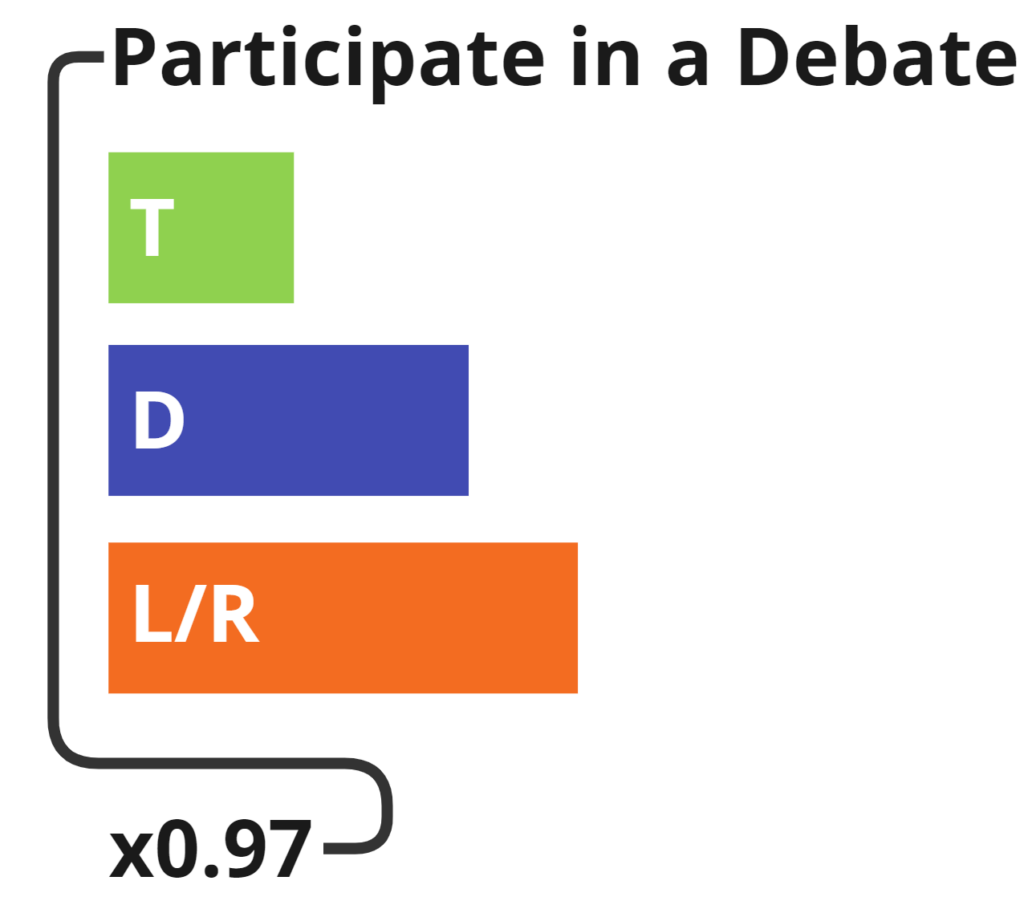
Final option: Propose your own idea to your teacher. Important components of any proposal should be that the activity helps you engage with an exploration of your ikigai, be it through other’s stories or your own, involves speaking English throughout on your part and includes a reflection about your growth. Your teacher will provide you with a multiplier score and a framework of instructions after consultation with the other 4H teachers.
Teacher Assignment

There is an assignment that scores ‘Low’ on Time, Difficulty and Reflection/Learning but it is an assignment for pupils who do not score the minimum passing grade (4.5*) and have very little time to resit this spoken project test in the final week of the school year.
Its multiplier is 0.85 meaning any points scored on it are multiplied by 0.85 resulting in a more difficult to pass assignment and a maximum grade of an 8.5.
*Usually because they were late handing in the Ikigai Project Product.
Quick Overview
Use the overview below (High-Risk, High-Reward) for more information about how long (T) and how difficult (D) the assignments/products are to execute (logistically as well as language level wise). L/R tells you how much you can learn (L) through Reflection (R).
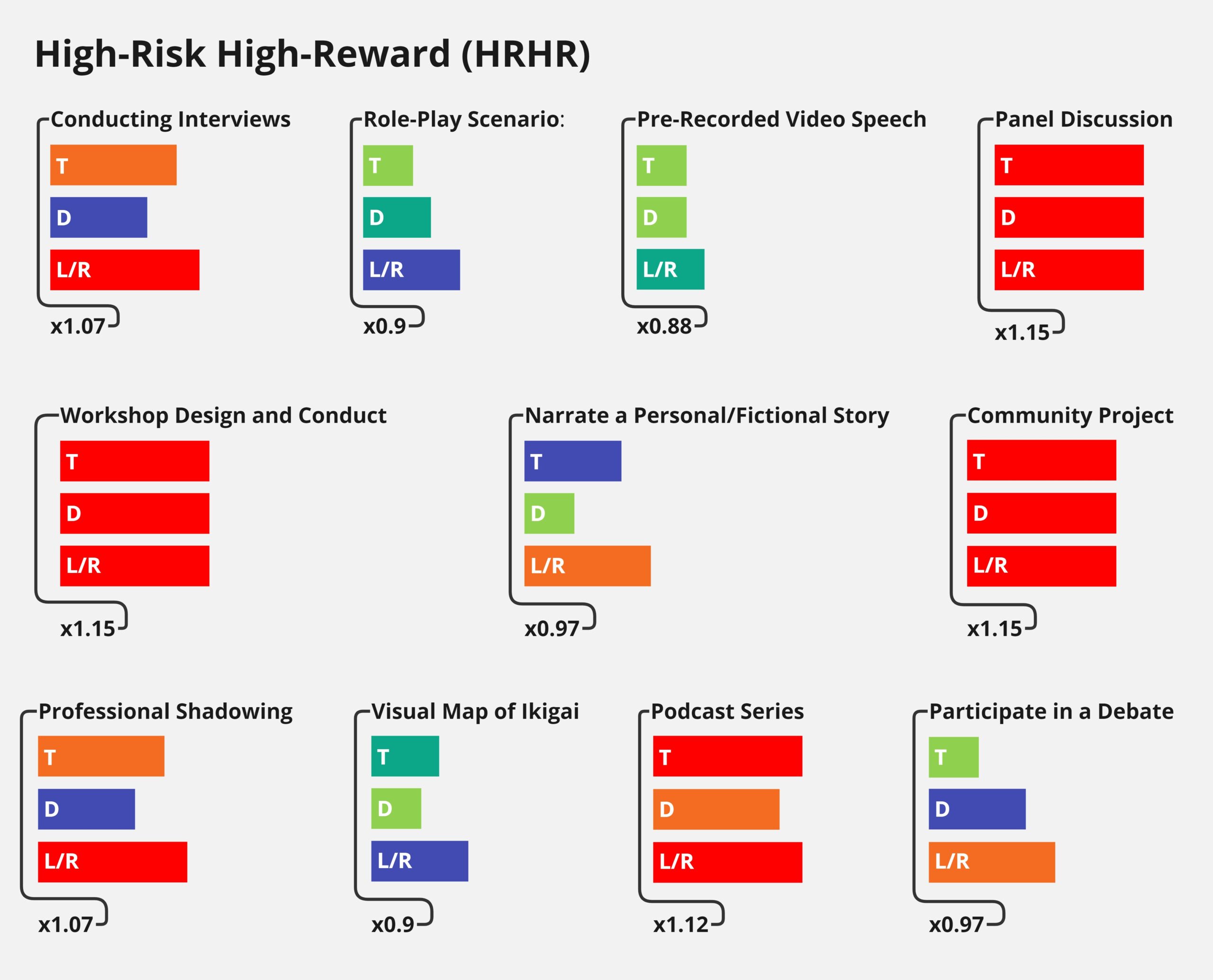
How were the levels determined?
- Time: A lot of planning and organization is needed, and the action that needs to be recorded takes a certain amount of time.
- Difficulty: How hard something is depends on how much language is used, how much creativity is needed, and what the topic is.
- Learning/Reflection: depends on how many other people’s points of view, insights, and experiences are included in your product, how much self-reflection is needed to make it happen, and whether the activities offer high-reward or real-life learning chances.
Grading
In general, assignments that are longer and harder and may teach you more get better grades than tasks that are easier and shorter. We hope that this way, the more interesting tasks will be picked, even if they are harder or take longer.
Handing in your product after the deadline
If you submit your project late without previously agreed and justified arrangements with your teacher, the following late submission policy will apply. Similarly, if you have been granted an extension but still fail to submit your work by the revised deadline, your grade will be subject to a similar reduction.

How does it work?
When grading your Ikigai project, a special multiplier will be added to your total points (0–100) to make sure you get a fair grade, taking into account how different each task is. This multiplier is figured out by looking at three things: the time, the difficulty, and the amount of learning and reflection that went into each task.
Multiplier
These factors have values that run from 0.85 to 1.15, and the multiplier is the average of those values. A task that takes more time might have a higher value for the “Time” factor, while a task that is easier might have a smaller value for the “Difficulty” factor. Click on the HRHR Legend to see it.
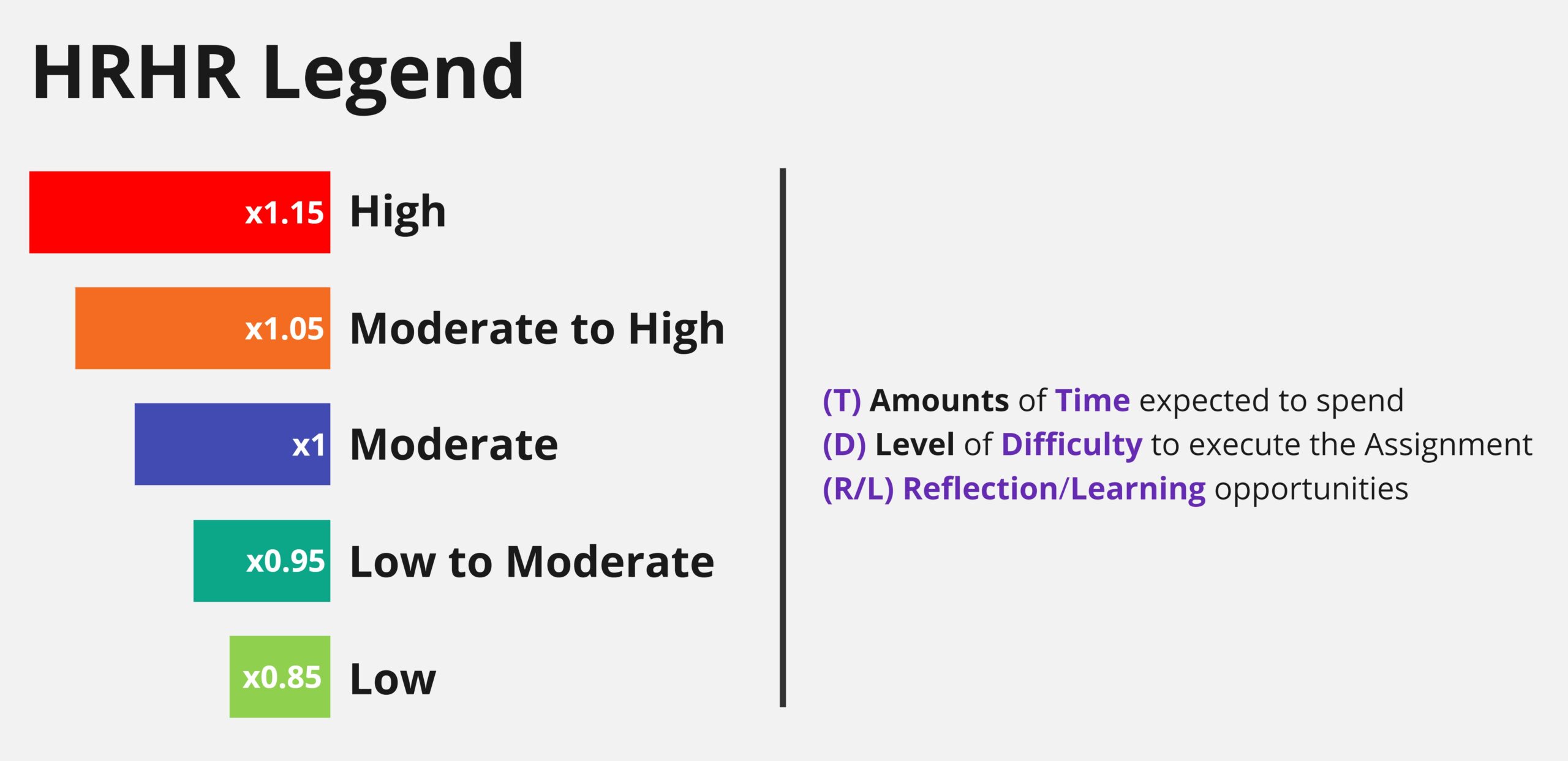
Here’s how it works:
- Base Points: You’ll first be awarded points out of 100 based on the rubric.
- Multiplier Application: Your points will then be adjusted by the unique multiplier for your chosen assignment. For instance, if you choose to “Organize a Panel Discussion” and earn 80/100 points, your adjusted points will be 80 x 1.15 = 92/100. Likewise, 80/100 Points for the ‘Visual Map of Ikigai’ will be 72 (80 x 0.90 = 72).
We carefully calculated these multipliers to make sure they are fair and to encourage you to pick the task that speaks to you the most while still challenging you. For each task, the multipliers are shown visually in the form of bar graphs to help you understand how the grades work better.
Remember, the purpose of this project is to explore your Ikigai and grow from the experience. Choose the assignment that intrigues you the most and embark on this insightful journey!
Good luck!
Product Assessment Rubric
📜 Important Exam Info
Het maken van de juiste studiekeuze is van grote invloed op de toekomst van leerlingen. Decanen en studiekeuzeplatformen geven daarom ondersteuning die gebruikt kan worden in de mentorles, en ook universiteiten bieden vanuit hun kant begeleiding door het inrichten van studiekeuzechecks. De rol van de vakdocent in dit proces is echter onderbelicht gebleven, terwijl ook diens begeleiding van groot belang is – en zelfs wettelijk verplicht.
Levende Talen Magazine
Wettelijke Opdracht
Het geven van aandacht aan het keuzeproces voor een studie en/of beroep is wettelijk vastgelegd in de examendomeinen van o.a. het examenvak Engels. Zoals je wellicht al gemerkt hebt, bieden we in dit project ook ruimte aan de verkenning van andere keuzes buiten studie en beroep.
Learning Goals (PTA and CEFR)
Please read the PTA (examenprogramma) descriptors below.
In year 4H, this project helps you prepare for important parts of your year 6V exams and in this case, the rest of your life.
It can be helpful to glance over the assignments/products first as the goals will make more sense to you if you know their context.
1 Examenprogramma (PTA)-koppeling (focus)
Domein F: Oriëntatie op Studie en Beroep
2 Examenprogramma (PTA)-koppeling
Domein A Leesvaardigheid
1 De kandidaat kan:
- de betekenis van belangrijke elementen van een tekst aangeven;
- relaties tussen delen van een tekst aangeven;
- conclusies trekken met betrekking tot intenties, opvattingen en gevoelens van
de auteur.
- In de explore phase, wanner leerlingen de samenvatting van de studie lezen.
Domein B: Kijk- en luistervaardigheid
2 De kandidaat kan:
- conclusies trekken met betrekking tot intenties, opvattingen en gevoelens van de spreker(s);
- In de explore phase, wanneer de leerlingen de video over Ikigai kijken.
Domein C: Gespreksvaardigheid
Subdomein C1: Gesprekken voeren
3 De kandidaat kan:
- adequaat reageren in sociale contacten met doeltaalgebruikers;
- informatie vragen en verstrekken;
- uitdrukking geven aan gevoelens;
- zaken of personen beschrijven en standpunten en argumenten verwoorden;
- strategieën toepassen om een gesprek voortgang te doen vinden.
- Tijdens de meeste zo niet alle te kiezen opdrachten/producten.
Subdomein C2: Spreken
4 De kandidaat kan:
- De kandidaat kan verworven informatie adequaat presenteren met het oog op
- doel en publiek, en daarbij zaken of personen beschrijven en standpunten en
- argumenten verwoorden.
- Tijdens de meeste zo niet alle te kiezen opdrachten/producten.
Domein D: Schrijfvaardigheid
Subdomein D1: Taalvaardigheden
5 De kandidaat kan:
- adequaat reageren in schriftelijke contacten met doeltaalgebruikers;
- Ter voorbereiding op de meeste producten/opdrachten
- informatie vragen en verstrekken;
CEFR
B2 Learning Goals
Hey there! If you look to your left, you’ll see a handy picture listing all the B2 learning goals. Don’t worry, you don’t need to cram all of it into your head! This picture breaks down what you’re going to learn for each of the five skills in your pre exam year and exam year. We’ve also got similar pictures for the A1, A2, and B1 levels. A1 and A2 were dealt with in your lower form years such as 2 havo and 2 vwo.
Oh, and one more thing! For your exams, you’ll need to show off your skills at levels B2 through C1 for a bunch of these skills. Check out this page to see what levels you will have to achieve. So it’s really important to understand how this project is setting you up to ace your school exams and the big Centraal Schriftelijk Examen. So, get stuck in and let’s ace these exams together!
Select an assignment (further down on the page) and write in your notebook which learning goals you think you will work on.
You will select one of twelve assignments in this project. That means you will work on different skills and sub-skills depending on the choice you make.
Look at the Learning Goal image B2 above and compare it to the assignment you choose.
Write down which of the learning goals (Writing, Reading, etc.) you will be working on, their descriptors (e.g. I read for information: I understand specfic…) and during what activities you will undertake (e.g. I will be reading newspaper articles about Ikigai and…).

Descriptor
Activity
Descriptor
Activity
Descriptor
Activity

Check out the explore phase to fill this out but also consider what other reading you plan to do to create your chosen assignment.
Descriptor
Activity
Descriptor
Activity
Descriptor
Activity

Descriptor
Activity
Descriptor
Activity
Descriptor
Activity

Descriptor
Activity
Descriptor
Activity
Descriptor
Activity

Check out the explore phase to fill this out but also consider what other listening you plan to do to create your chosen assignment; if you are going to interview for example, you will be listening too.
Descriptor
Activity
Descriptor
Activity
Descriptor
Activity
Timeline
- Week 13 = start of Ikigai
- Week 13-17 Work on Ikigai as well as W/L, Reading and Wr test prep.
- Week 17 and 18: May Holiday
- Week 19 and 20: Work on Ikigai (make haste!) and Writing test
- Week 21 – 22 test week (W/L and Reading test) / ascension day
- Week 23 excursion week
- Week 24: Hand In Ikigai Project Product on the 13th of June
- Week 25: Resits (herkansingen) test week 1 and 2, ikigai viewing
- Week 26: grade deadline, Ikigai viewing
- Week 27: ikigai viewing
- Week 28: project days
Rewards
The Rewards of This Project 🏆
This project offers approximately 500XP over the course of several weeks. While XP is an incentive to keep you engaged and motivated, it’s crucial to understand that it’s not the sole reward here. The real prize? Achieving the learning goals and potentially discovering your IKIGAI!
Grades: The Tangible Rewards 📝
Let’s not forget about grade—this numerical evaluation for speaking and the extent in which you research and report on your Ikigai discovery journey provide a measure of your skills such as spoken production, and engagement. Each component of this project—from the quizzes to talking to classmates about their Ikigai, participating in discussions and delivering the product—will ultimately contribute to your grade.
Read more
GEMs: For the Overachievers 💎
As is the tradition at Let’s Grow!, GEMs are awarded to those who go above and beyond. Consistent use of English during the project will earn you these precious points. But there’s more:
- Score a 7 for your Ikigai Product: Earn 25 GEMs
- Score an 8 for your Ikigai Product: Earn 50 GEMs
- Score between a 9 and 10 for your Ikigai Product: Earn 60 GEMs
Remember, while XP, grades, and GEMs are incentives, the ultimate reward is your growth as a person and finding out more about what you would like to do in life. So let’s get started on this rewarding journey! 🌟
Vocab
See ‘study vocab’ in the steps.
Grammar
Let’s dive into the exciting world of English conditionals, focusing on the first and second types! 🌟
Picture this: conditionals are like time travelers in the language universe. The first conditional is your guide to probable future adventures. It follows the formula: If + present simple, will + infinitive. For example, “If it rains, I will bring an umbrella.” It’s like making a plan based on what might happen!
Now, let’s meet the second conditional, the dreamer of the bunch. It’s used for imagining scenarios that are less likely or even just hypothetical. The magic formula here is: If + past simple, would + infinitive. Think of it like a wish or a daydream: “If I were a millionaire, I would travel the world.”
How does the second conditional relate to the concept of Ikigai?
Understanding the First and Second Conditionals
First Conditional – The World of Real Possibilities:
- Structure: If + Present Simple, will + Infinitive
- Usage: The first conditional deals with real and possible situations in the future. It’s like making a prediction based on certain conditions.
- Example: If it rains tomorrow, I will take an umbrella.
Imagine you’re a weather reporter. You’re not sure if it will rain, but you’re ready with a plan in case it does. That’s the first conditional – it’s all about what you would do in a likely future scenario.
Second Conditional – Imagining Different Realities:
- Structure: If + Past Simple, would + Infinitive
- Usage: This conditional is for hypothetical situations, often dreams or unlikely scenarios. It’s about imagining what you would do in a different reality.
- Example: If I won the lottery, I would buy a house.
Think of the second conditional as your own storytelling tool. It’s like creating a fantasy world where you explore what could happen in an alternate universe, even if it’s not very likely to occur.
Practice Tips:
- First Conditional Practice: Write down a few predictions about the next week. What will you do if certain conditions are met? For instance, “If the sun shines, I will go for a walk.”
- Second Conditional Practice: Let your imagination flow. Write about what you would do in impossible or unlikely situations, like “If I could fly, I would visit all the countries in the world.”
- Compare and Contrast: Create pairs of sentences for similar situations using both conditionals. This will help you see the difference in their applications.
Remember, mastering conditionals is not just about learning rules; it’s about understanding how to express different levels of probability and imagination in your conversations and writing. Enjoy exploring the possibilities! 🌈✨
First Conditional Signal Words: The first conditional often involves signal words that indicate future possibilities or plans. These include:
- If: The primary indicator of a conditional sentence.
- When: Suggests something is likely to happen.
- Unless: Indicates an exception to what will happen.
- As long as, Provided (that), Providing (that): Set conditions for the action to occur.
- In case: Prepares for a future possibility.
Example: “If it’s sunny, we’ll go to the beach.”
Second Conditional Signal Words: The second conditional typically uses words that imply hypothetical or unreal situations. These include:
- If: Also used here but in hypothetical contexts.
- Were (with ‘I’ or ‘He/She/It’): Often used instead of ‘was’ to indicate hypothetical situations.
- Would: A key word indicating hypothetical actions.
- Could: Suggests possibility in a hypothetical context.
- Might: Indicates a less certain possibility.
Example: “If I were a bird, I would fly around the world.”
In the second conditional, which is used for hypothetical or unlikely situations, “would” is the most commonly used modal verb. However, there are alternatives that can be used to express different shades of meaning or possibility. Here are some alternatives to “would” in second conditional sentences:
- Could: This implies a possibility or ability in a hypothetical situation.
- Example: “If I had a million dollars, I could travel the world.”
- Might: This suggests a less certain or more speculative outcome.
- Example: “If I were president, I might change the education system.”
It’s important to note that while “could” and “might” can replace “would” in some second conditional sentences, they slightly change the meaning. “Could” often focuses on ability or possibility in the hypothetical scenario, whereas “might” introduces a sense of uncertainty or speculation about what one might choose to do.
Remember, the choice of modal verb (would, could, might) in a conditional sentence can subtly change the meaning, reflecting different levels of likelihood, ability, or willingness in the hypothetical situation.
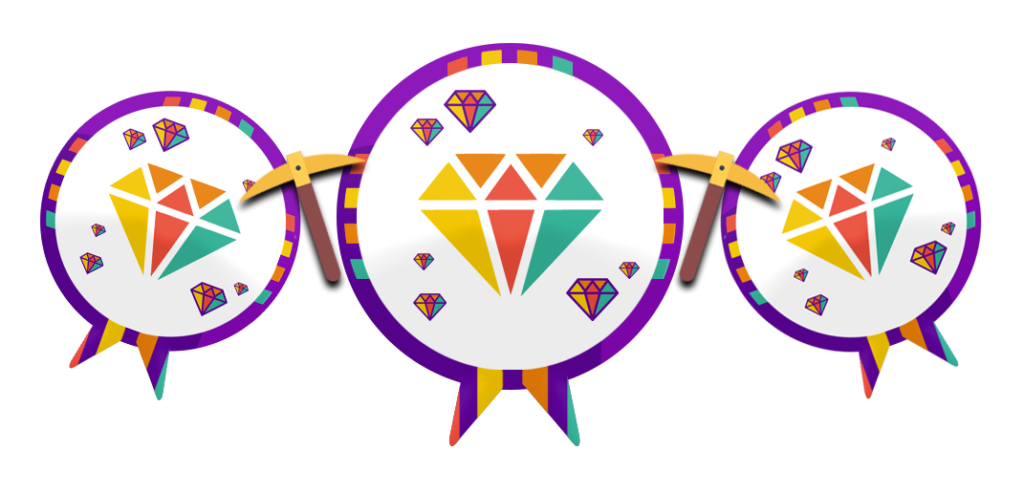
Mining Expeditions
Welcome to the Mining Expedition Ikigai Project!
Hello, Adventurous Pupils! Today, we embark on a unique journey, one that blends the rhythms of music with the thrill of discovery – the Mining Expedition Ikigai Project. This isn’t just any ordinary class activity; it’s a quest to unearth the gems of self-awareness and passion, deeply embedded in the bedrock of our identities.
You’re probably wondering, “What does a song from 2004 have to do with mining?” Well, let’s find out! The song “Unwritten” by Natasha Bedingfield, a hit that keeps reappearing in our lives through social media, carries a powerful message that resonates with our mission.
🎵 Activity A: Lyric Discovery 🎵 In this section, you’ll dive into the lyrics of “Unwritten”. But here’s the twist – some words are missing! Your task is to listen to the song and fill in the gaps. Think of it as unearthing hidden gems in a musical landscape. Each correct word you find earns you GEMs (bonus points)!
🔍 Activity B: Lyric and Personal Analysis 🔍 Now, it’s time to wear your analyst hats! You’ll delve into the lyrics, seeking connections with the concept of Ikigai – your reason for being. Through discussions and written reflections, you’ll explore how the song’s themes align with your journey of self-discovery and purpose.
🌟 Creative and Comparative Analysis 🌟 Get ready to unleash your creativity! Compare “Unwritten” with another song or poem that speaks to you about self-discovery. How do they differ? How are they similar? Even more exciting, you’ll have the chance to add your verse to the song, weaving in your understanding of Ikigai.
🔮 Future-Oriented Reflection 🔮 Finally, ponder the open-ended nature of your future, just like the unwritten pages of a book. Reflect on how this outlook supports your ongoing journey of discovering your Ikigai and compare it to insights from our class materials.
This expedition isn’t just about earning XP for your grades. It’s an opportunity to explore, understand, and express yourself. Each step, each discovery, brings you closer to understanding your unique Ikigai. So, let’s start this journey together, and remember – the rest is still unwritten! 🚀✨
Assignment Rubric: Lyric Analysis and Personal Reflection
- Any basic, limited or insufficient score means you have to make changes before you can receive your GEMs.
- 45/55 or more points required to get your 100 GEMs.
- Scoring 55/55 points constitutes an extra 50GEMs award.
- Only assignments handed in in Magister Opdrachten with a plagiarism check result of less than 10% are accepted.
- Avoid copying the lyrics or other instructions written by us into your document to prevent being flagged for plagiarism.
Criteria for Assessment:
Identification of Resonating Line (5 points):
- Excellent (5): Clearly identifies a line from the song that resonates with the idea of finding one’s passion, with a thoughtful explanation.
- Proficient (4): Identifies a line, but the explanation may lack depth.
- Basic (3): Identifies a line with a brief explanation.
- Limited (2): Identifies a line but provides an unclear or inadequate explanation.
- Insufficient (1): Fails to identify a resonating line.
Understanding of Ikigai Concept (10 points):
- Excellent (10): Demonstrates a deep understanding of how the lyrics “I am unwritten, can’t read my mind, I’m undefined” reflect the concept of ikigai, with clear and insightful analysis.
- Proficient (8): Provides a good understanding of the connection between the lyrics and the concept of ikigai.
- Basic (6): Offers a basic explanation of the connection, but lacks depth.
- Limited (4): Mentions the connection but provides a vague or unclear explanation.
- Insufficient (2): Fails to connect the lyrics to the concept of ikigai.
Interpretation of “Dirty Window” Symbolism (5 points):
- Excellent (5): Provides a thoughtful interpretation of the phrase “Open up the dirty window” and explains its relevance to the process of discovering ikigai, with a clear understanding of what the ‘dirty window’ symbolizes.
- Proficient (4): Offers an interpretation and relates it to discovering ikigai but may lack some depth.
- Basic (3): Provides a basic interpretation but lacks clarity or depth.
- Limited (2): Offers a vague or unclear interpretation.
- Insufficient (1): Fails to interpret the symbolism adequately.
Emphasis on Individuality (5 points):
- Excellent (5): Clearly explains how the line “Feel the rain on your skin, no one else can feel it for you” encourages individuality in the journey of finding ikigai.
- Proficient (4): Explains the encouragement of individuality but may lack some depth.
- Basic (3): Offers a basic explanation of individuality but lacks clarity or depth.
- Limited (2): Provides a vague or unclear explanation.
- Insufficient (1): Fails to explain the encouragement of individuality.
Assignment Rubric: Comparative Analysis and Creative Application
Criteria for Assessment:
Comparative Analysis (10 points):
- Excellent (10): Conducts a thorough and insightful comparison between “Unwritten” and another song or poem related to ikigai, highlighting clear similarities and differences.
- Proficient (8): Provides a good comparative analysis but may lack some depth or clarity.
- Basic (6): Offers a basic comparison with limited depth.
- Limited (4): Provides a comparison with vague or unclear points.
- Insufficient (2): Fails to effectively compare the two pieces.
Creative Application (10 points):
- Excellent (10): Creates an additional verse for “Unwritten” that effectively incorporates the elements of ikigai, demonstrating a deep understanding of the concept.
- Proficient (8): Creates an additional verse with elements of ikigai, but it may lack some depth or creativity.
- Basic (6): Offers a basic additional verse with limited depth or creativity.
- Limited (4): Provides an additional verse with vague or unclear elements related to ikigai.
- Insufficient (2): Fails to create an additional verse effectively.
Assignment Rubric: Future Orientation and Integration with Explore Phase
Criteria for Assessment:
Future-Oriented Outlook (5 points):
- Excellent (5): Clearly explains how the song’s outlook of an open future with unwritten pages supports the ongoing journey of discovering and evolving one’s ikigai.
- Proficient (4): Explains the future-oriented outlook but may lack some depth or clarity.
- Basic (3): Offers a basic explanation of the future-oriented outlook with limited depth.
- Limited (2): Provides a vague or unclear explanation.
- Insufficient (1): Fails to explain the future-oriented outlook.
Integration with Explore Phase (5 points):
- Excellent (5): Effectively contrasts the message from the song with one of the lines from the younger character expressed to the older character in the kitchen in the short clip posted in the explore phase, highlighting clear connections and differences.
- Proficient (4): Contrasts the message from the song with the explore phase clip but may lack some depth or clarity.
- Basic (3): Offers a basic contrast with limited depth.
- Limited (2): Provides a vague or unclear contrast.
- Insufficient (1): Fails to effectively contrast the two sources

